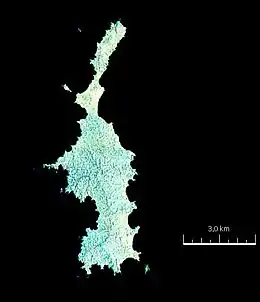Lobos de Tierra
Lobos de Tierra is a Peruvian island situated 19 km from the mainland close to the Illescas Peninsula and the boundary between the departments of Piura and Lambayeque regions.[1] Its area is 16 km2,[1] its approximate length is 10 km, and its approximate width is 3 km.
 Satellite view of the island. | |
 Lobos de Tierra Island Location of the island | |
| Geography | |
| Location | Pacific Ocean |
| Coordinates | 6°25′40″S 80°51′29″W |
| Area | 16 km2 (6.2 sq mi)[1] |
| Length | 10 km (6 mi) |
| Width | 3 km (1.9 mi) |
| Administration | |
| Region | Lambayeque |
| Additional information | |
| Time zone | |
Natural resources
In 1863 the island was estimated to have guano deposits of almost 7 million metric tons,[2] which were then exploited without any control. The number proved to be an overestimate[2] and today that wealth has almost disappeared and the little remaining guano does not have the same quality as before.
The climate of this island is very warm and is home to birds like kelp gulls,[3] boobies (Blue-footed, Nazca, and Peruvian),[4][5] and Guanay cormorants.[4] The last two species were of great importance during the heyday of guano. Lobos de Tierra Island owes its name to its proximity to the coast and the presence of otariids. At times blue whales can be seen.[6]
Geography
Around the island there are several islets such as El León and Albatros.
See also
References
- Instituto Nacional de Estadística e Informática (Peru). Perú: Compendio Estadístico 2008. 1.11: Superficie insular, según departamento (p. 25)
- Cushman, Gregory T. (2013). Guano and the Opening of the Pacific World: A Global Ecological History. Cambridge University Press. p. 59. ISBN 9781107004139.
An 1863 survey of the islands north of Lima identified 6.8 million metric tons of phosphatic guano on Isla Lobos de Tierra alone. All of those proved to be gross overestimates.
- Hince, Bernadette (2000). The Antarctic Dictionary: A Complete Guide to Antarctic English. Csiro Publishing. p. 199. ISBN 9780643102323.
The subantarctic Dominican or Kelp Gull (Larus dominicanus) is an even more remarkable invader, for it finds centres of maximum abundance, as a nesting bird, at localities so utterly unlike as the Strait of Magellan and Lobos de Tierra Island.
- Schulenberg, Thomas S.; Stotz, Douglas F.; Lane, Daniel F.; O'Neill, John P.; Parker, Theodore A., III (2010). Birds of Peru. Princeton Field Guides (Revised and updated ed.). Princeton University Press. pp. 68, 70, 72. ISBN 9781400834495.
{{cite book}}: CS1 maint: multiple names: authors list (link) - Glynn, P. W., ed. (1990). Global Ecological Consequences of the 1982–83 El Niño-Southern Oscillation. Elsevier. pp. 382–383. ISBN 9780080870908.
The Blue-footed Booby has a relatively wide breeding range -- from the Gulf of California, the Gulf of Panama (population ca 100 pairs, pers. obs.), the Galápagos, and southward to its overlap with the Peruvian Booby on Isla Lobos de Tierra, Peru.
- Marine Ornithology - Volumes 33-34 - Page 81 2005 - Peruvian Boobies on Lobos de Tierra are currently scarce, but their population in the middle of the last century probably exceeded 400000 individuals (Nelson I978).